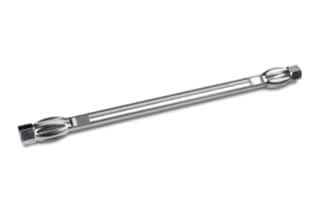
|
Chemistry |
C18 |
|
Separation Mode |
Reversed Phase |
|
Particle Substrate |
Hybrid |
|
pH Range Min |
2 pH |
|
pH Range Max |
12 pH |
|
Maximum Pressure |
6000 psi (415 Bar) |
|
Endcapped |
Yes |
|
Bonding Technology |
Shield RP18 |
|
Silanol Activity |
Low |
|
Particle Shape |
Spherical |
|
Particle Size |
3.5 µm |
|
Endfitting Type |
Waters |
|
Pore Size |
125 Å |
|
Format |
Column |
|
Surface Area |
175 |
|
System |
HPLC |
|
USP Classification |
L1 |
|
Inner Diameter |
3 mm |
|
Length |
150 mm |
|
Carbon Load |
15 % |
|
UNSPSC |
41115709 |
|
Brand |
XTerra |
|
Product Type |
Columns |
|
Units per Package |
1 pk |

XTerra Shield RP18 Column, 125Å, 3.5 µm, 3 mm X 150 mm, 1/pk
Get superior pH stability for your analysis when compared to a silica-based column by using the Waters XTerra Shield RP18 Column. The analytical column is a general-purpose, hybrid-based, reversed-phase C18 column that incorporates Waters’ patented embedded polar group technology to improve peak shape performance for highly basic compounds. The Waters XTerra family of reversed-phase HPLC columns is the first commercially available alternative to silica-based column technology, making them a crucial part of any lab.
The XTerra Shield RP18 Column uses the Waters patented organic/inorganic Hybrid Particle Technology (HPT). This makes it possible for you to overcome the significant limitations of the silica-based reversed-phase packing materials, specifically their hydrolytic instability at high pH.
Benefit from key advantages offered by the XTerra Shield RP18 Column over its silica counterparts such as mechanical strength, highly spherical shape, purity, pore dimensions, surface area, ability to tailor particle size, pore dimensions, surface area, and surface chemistry. The column achieves this by leveraging traditional bonding agents, making it a general-purpose piece of lab equipment that is able to deliver peak shape performance for highly basic compounds, maintaining high efficiency of separation and improved pH stability. The XTerra Shield RP18 column listed here can operate within a wide-scale pH range (2-12) and tolerate up to 6,000 psi (415 Bar) pressure.
The XTerra Shield RP18 column is made using a high purity methyl hybrid material and is produced through a method similar to how high-purity silica is manufactured with one major difference: that the XTerra material is formed from the mixed condensation of two high purity monomers instead of one. Tetraethoxysilane (TEOS) and methyltriethoxysilane (MTEOS) are used to perform the Hybrid Particle Synthesis of the XTerra Shield RP18 columns.
You learn more about the manufacturing process and material used in the XTerra Shield RP18 column by browsing through our catalog or website. Both the mediums also enable you to shop for lab equipment.
You may also want to explore the XTerra Shield RP18 VanGuard Cartridge, 125Å, 3.5 µm, 2.1 mm X 5 mm, 3/pk.
What Is The Difference Between Stationary Phase And Mobile Phase?
The stationary phase and mobile phase are two important terms in chromatography, which is a technique of separation and identification of the components in a mixture. The main difference between the stationary and mobile phases is that the stationary phase does not move with the sample, whereas the mobile phase moves with the sample.